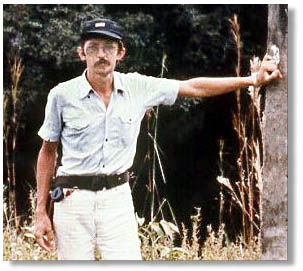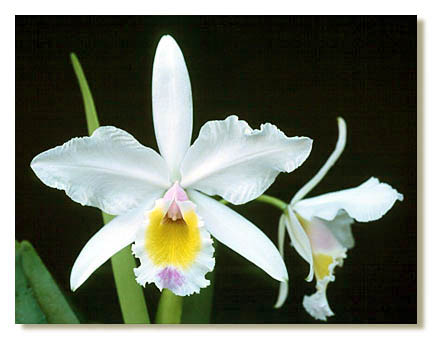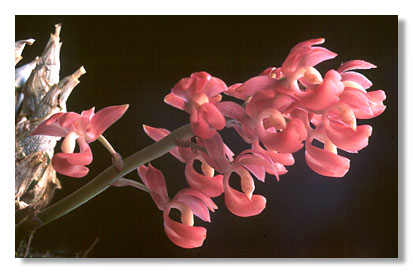
 |
| Kleber
Garcia de Lacerda Júnior, physician and specialist in tropical diseases,
born in Minas Gerais, is nowadays considered as a great expert in Brazilian orchids
known as "Catasetinea" (Catasetum, Cycnoches and
Mormodes). Due to his job, he spent at about 13 years in the Amazon region (north region) when he researched with great interest the Orchidaceae family. Going beyond Brazilian states, he also traveled over Colombia, Ecuador and Venezuela. A pioneer work in the state of Rondonia, between l979 and l980, brought him to discover many new species of Catasetum, Mormodes and a Lycaste. He also verified many new citation to Brazil and rediscovered some species which were not related for a century. |

|
| Nowadays
in cooperation with another researchers, he is doing a review of the genus Catasetum
Rchb.f. ex-Kunth. Besides the new species already described, there are another
6 discoveries just about to be published (Catasetinea, Bulbophyllum
and Laelia). The botanist Pedro Ivo S. Braga paid homage to him with a
species described in 1981, Catasetum kleberianum. Presently, he directs
his efforts to study the Orchidaceae flora of Minas Gerais where he lives
and practices medicine and psychiatry. However, he often goes to the north region
in order to continue his studies. In this interview, he tells us about environmental conditions of the Amazon region (temperature, humidity and rainfall), about genera and species that occur in the region, such as Brassia, Cattleya, Epidendrum, Galeandra, Scuticaria, Bifrenaria, and Oncidium. Pleurothallis, Octomeria, Caularthron and, very specially, about Catasetinae, brief, he tells us about the diversity of Orchidaceae family in the Amazon region. He discourses about the influence of Brazilian or foreign researchers upon his work, about the several habitats of the region, dryland forests (thick rain forests), Mid Amazon woodlands (campinas), forests of várzeas (fertile plains) and igapós (flood forests), etc. and about a macucu tree (Aldina heterophylla Spr. ex Benth) with nothing less than 45 species of orchids. He remembers the "Associação de Orquidófilos of Amazonas" (the local association that he and his companions have found) and he clarifies many doubts about synonymies and nomenclature. Meet a little of this unknown world formed by the Brazilian Amazon through Kleber Garcia's eyes. |
| Orchid
News - Kleber, nowadays, you are considered as a great expert in "Catasetinea".
Could you tell how did it start? How did arouse your interest in the study of
orchids, first as a grower then as a orchidologist? You were already graduated
in Medicine or all those things started before? Kleber Lacerda - Even before graduating, I have been concerned by Biology, mainly in Entomology. Botany had less important however it has got my attention when I did an excursion to Serra do Cipó and noticed carnivore plants, selaginelas and some orchids. During part of my stay at the Medical Clinic in the Hospital of Clinics of UFMG (Federal University of Minas Gerais), in the Advanced Campus of Tropical Diseases in Amapá, just a few expeditions into the wood were enough to induce readings that stimulated my curiosity particularly about the Amazon flora. The cultivation and the study have developed at the same time but, due to my constant move-house because the local of my post-graduation, I never could have a great collection, more then once I should give up my plants, distributing them to my friends. ON - Even going to this region because of your job, this stay was extremely profitable concerning the point of view the orchids. How long did you stay there? KL - I lived there for at about thirteen years, five in the interior of the states of Para and Amazonas, almost eight in Manaus and besides two in Ecuador Amazon region. Then I came back to Minas Gerais but I should return many times to the North region to go on medical activities. As my job required frequent travels to many places in all region called "Amazônia Legal", it was easy to discover ecological niches not yet explored; traveling in small aircraft, motor boat and helicopters, things that were impossible to do for my own self... Sometimes, instead of returning to Manaus during the weekends, as my companions used to do, I decided to stay at the front of the works and explore the region when it showed promising under the point of botanical view. ON - Reading your works about the Amazon region we can notice the great knowledge you have got about the region during your stay. What have you to say about the climatic conditions, the difficulties of adaptation? KL - The human being fits well with many environmental conditions and it is very difficult that somebody does not tolerate Amazon climate; with plants, we can not say the same. I had the opportunity to try the cultivation of many different vegetal species of subtropical and temperate regions when I lived in Manaus, such as vegetables, palm trees, trees, different ornamental plants and orchids, with amazing results, even funny, sometimes, - for example, pepper trees that reached three meter height, tomatoes trees that grown as ascendant plants over the roof, carrots with enormous foliages but with rachitic, underdeveloped roots, Dendrobium (mainly nobile) that vegetated wonderfully but never bloomed, plants that changed their colors and lost their foliar hair, some others that have never given fruits, etc. All this is due to the agents as pluviometric precipitation, temperature, relative humidity of the air, intensity and duration of the luminosity during the year (photo-period), composition and pH of the soil (substrate), lack of pollinators and many other agents. The most part of the population lives in the Amazon's plain, in altitude bellow 200 m above sea level, hot all over the year (the maximum average is at about 33º C, and the minimum - during the night - is about 24 º C); we should consider that the excessive humidity of the air intensifies the sensation of heat. There is a short stop rain period, varying from 2 to 4 months. However, in the interior, the temperature drops more than this, mainly during the night and in the higher regions, it can be cold. In the woodlands next to Manaus, at night, we can have 18º C or less, sometimes. Reproducing this climate in other region is not very difficult. Here in Belo Horizonte, I have a small greenhouse where, with very small costs, I succeed in cultivating some Amazon orchids. |
 |
Of
course, the species react in different ways: Brassia, Cattleya eldorado, Cattleya lawrenceana, Epidendrum, for example, have more flexibility concerning the conditions of temperature, humidity and luminosity. Nevertheless, Cattleya violacea, Galeandra, Scuticaria, Caularthron and some others are very exacting and require narrower limits in the conditions |
|
Regarding Catasetinae and Oncidium, the behavior varies according
to the species, or even inside the same species, according to the region they
come from. This is true to native plants, conditioned by metabolic adaptive answer.
Plants reproduced by seeds and artificially developed are in general more adaptable
to cultivation in other region. ON - You have already said that you went to the Amazon region in Ecuador besides the Brazilian Amazon, which states and countries you have also researched? In what way you carried on the researches, have you worked alone or with someone else? KL - I can not consider my self as self-taught because I had different informal teachers who really helped me in the introduction to Botany, with emphasis on Orchidaceae family. In Manaus, Professor Pedro Ivo, Master in post-graduation courses at INPA and then in Belo Horizonte as Professor titular of the Botany Department of UFMG (Federal University of Minas Gerais), taught me how to study and research within the more rigorous scientific principles. By his influence, I could improve my self and could assimilate easily ethical principles since they flow from him spontaneously. With Professor Marilene Nogueira, former in INPA and nowadays as titular professor of the Botany Department of UFMG, I could understand how to research Morphology and having a critical look about the nuances of vegetal forms. The conviviality of many companions of the Associação de Orquidófilos da Amazônia, such as the botanist Francisco Miranda, and researchers coming from another areas, made possible the interchange of knowledge and my personal development. In Ecuador I had the opportunity of meeting, sometimes, Professor Calaway Dodson, exponent of Orchidaceae taxonomy, enough to make me understand how we should work in this area which attracted me more. In the fieldwork, I could go with the eminent Professor Robert Dressler and his staff in their scientific expeditions in the east region of the country - and thus I could assimilate techniques of work. Many times, João Batista F. Silva has been my companion in the excursions inside the Brazilian Amazon and collaborator with precious information. More recently, with Professor Gustavo Romero, from Harvard University, United States and with the companions of ABRACC (Catasetinae Association), standing out the deeply missing Professor Hamilton Bicalho, important information have been assembling to form a big data center. Professor Vitorino C. Paiva Neto has been being an important interlocutor to whom I am in debt because of his unselfish cooperation. Hither and thither, I have been meeting people that give positive contribution, but it is impossible to nominate all of them. In Brazil, I could search accurately all the states of north region, in the neighborhood of my houses, in short travels in jeeps or boats as well as far border regions in aircraft and small boats, in more prolonged excursions. |
||
| Unforgettable was an adventure in a region named "Cabeça de Cachorro" (Head of Dog), in the borders of Colombia, Içana river and tributaries where I found the new Mormodes issanense.Fifteen days of surprises, discoveries, risks and tragicomic episodes... |  |
|
At
least once a year I still try to go to the north region; The last time was in
Mai 2000, with Professor Pedro Ivo when we tried to get the place where I found
Catasetum kleberianum described by him. When we were at about 30 km to
get our destination we could not go on because the road has had been totally destroyed
by the flood; getting there by river would take a week and we did not have time.
Nowadays I study the Orchidaceae flora of Minas Gerais, trying to clarify some
doubts mainly about Laelia, and, at least, once a month I go to a habitat where
I work for 1 or 3 days. Professor Karl Meyer, from Belo Horizonte, is a great
companion in many expeditions and I have been taking advantages of his rich knowledge
about the Orchidaceae flora of Minas Gerais and Espírito Santo. |